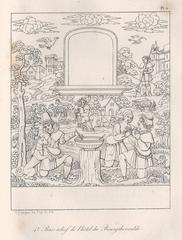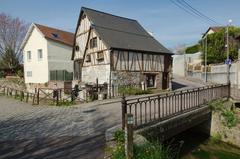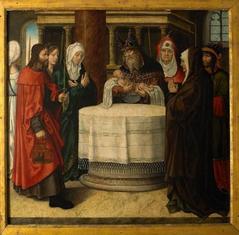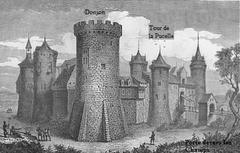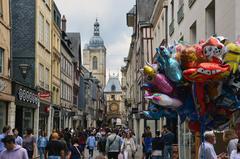Muséum d’Histoire Naturelle de Rouen: Visiting Hours, Tickets, Renovation Updates & Travel Guide
Date: 04/07/2025
Introduction
Nestled in the historical core of Rouen, Normandy, the Muséum d’Histoire Naturelle de Rouen stands as a testament to scientific curiosity, community engagement, and cultural heritage. Established in 1828 by the renowned naturalist Félix Archimède Pouchet, the museum has evolved into France’s second-largest natural history collection outside Paris, housing over 800,000 objects. Its unique blend of zoology, paleontology, botany, mineralogy, and ethnography—alongside rare fossils and immersive dioramas—makes it a cornerstone for both scientific research and public education.
This detailed guide explores the museum’s storied history, signature collections, practical visitor information, renovation updates, and travel tips—making it an essential resource whether you are planning a future visit or following the museum’s transformation. For the most current details and virtual content during the closure, consult the official museum website.
Contents
- Historical Overview and Institutional Evolution
- Key Collections and Highlights
- Visiting Information (Hours, Tickets, Accessibility)
- Renovation Status and Beauvoisine Project
- Educational and Community Initiatives
- Travel Tips and Nearby Rouen Attractions
- Frequently Asked Questions (FAQ)
- Summary and Call to Action
- References
Historical Overview and Institutional Evolution
Founding and Early Years (1828–1850)
The Muséum d’Histoire Naturelle de Rouen was founded in 1828 by Félix Archimède Pouchet, who envisioned a center that would democratize scientific knowledge and promote public education. Initially housed in the 17th-century Sainte-Marie convent, the institution quickly amassed collections through donations from naturalists, explorers, and local scholars. By 1834, it displayed over 6,000 objects, reflecting Enlightenment ideals and Rouen’s deep intellectual ties to the wider world (Ville de Rouen).
Growth and Scientific Impact (1850–1900)
Throughout the second half of the 19th century, the museum expanded its scope to include paleontology, botany, zoology, and ethnography. It became a hub for scientific research, notably contributing to debates on spontaneous generation and serving as a laboratory for experimental biology (Encyclopædia Britannica). The museum’s public lectures and educational programs made science accessible to a broader audience.
Architectural Modernization and Postwar Revival (1900–2000)
As the museum’s collection grew, renovations were undertaken to improve exhibition spaces and conservation standards. Despite challenges during World War II, the building and collections were preserved. After the war, the museum renewed its educational outreach, forged partnerships with schools, and began digitizing collections in the 1990s, furthering accessibility and international collaboration.
Contemporary Developments and Ethical Curation (2000–2025)
In the 21st century, the museum prioritized accessibility, ethical stewardship, and engagement with contemporary scientific challenges. Notably, it returned Maori heads (toi moko) to New Zealand in 2012, reflecting a commitment to global restitution movements (France 24). Digital resources and thematic exhibitions—on biodiversity, climate change, and more—ensure the museum’s continued relevance and reach.
Key Collections and Highlights
Scope and Diversity
With over 800,000 objects, the collections span:
- Zoology: Rare birds, mammals, insects, and historic taxidermy.
- Paleontology: Fossils from the Jurassic and Cretaceous periods, many sourced from Normandy.
- Botany: Extensive herbarium, seeds, and botanical models.
- Mineralogy: Vibrant mineral specimens and notable dinosaur skeletons.
- Ethnography: Over 40,000 artifacts from Africa, Asia, Oceania, and the Americas, curated in partnership with descendant communities (Muséum d’Histoire Naturelle de Rouen).
Exhibit Highlights
- Normandy Dioramas: Immersive, period dioramas depicting local habitats and wildlife.
- Bird Gallery: Over 12,000 naturalized birds, including rare Antarctic specimens from the Charcot expedition.
- Ethnographic Galleries: The “Galerie des Continents” features collaborations with Indonesian artists and indigenous communities.
- Historical Curiosities: 19th-century anatomical specimens and curiosities reflecting the era’s scientific culture.
Visiting Information
Standard Visiting Hours (Pre-Closure)
- Tuesday to Sunday: 10:00 AM – 6:00 PM (last admission 5:30 PM)
- Closed: Mondays and certain public holidays
Note: The museum is currently closed for renovation (see below).
Ticket Prices
- Permanent Collections: Free admission
- Temporary Exhibitions/Workshops: Fees may apply, generally under €10–€15
- Discounts: Available for students, seniors, and families
- Online Booking: Recommended via the official website
Accessibility
- Wheelchair Access: Ramps and elevators throughout the museum
- Visitors with Disabilities: Facilities and support for motor and mental disabilities; “Tourisme et Handicap” label attained
- Languages: Most information in French, with English guides/materials available
Getting There and Facilities
- Location: 198 rue Beauvoisine, 76000 Rouen
- Transport: Central Rouen location, accessible by bus, tram, and Beauvoisine metro station. Free public transport on Saturdays; parking nearby.
- Amenities: Accessible restrooms, cloakroom, group visit booking, and family-friendly spaces
Renovation Status and the Beauvoisine Project
Temporary Closure and Ambitious Transformation
As of July 2025, the Muséum d’Histoire Naturelle de Rouen is temporarily closed for the ambitious Beauvoisine Project—a comprehensive effort to merge with the neighboring Musée des Antiquités and create a multidisciplinary museum complex, the future “Musée Beauvoisine” (museumderouen.fr; La Gazette du Patrimoine).
Project Goals
- Integration: Unite ethnography, archaeology, natural sciences, and local history into a seamless visitor experience
- Conservation: Collections—approximately 600,000 objects—are being transferred to a new, state-of-the-art conservation center in Déville-lès-Rouen (France Bleu)
- Modernization: Incorporate new technologies and ensure full accessibility
- Reopening: Scheduled for 2028, with updated museography and expanded public programs
Community Engagement During Closure
While the main site is closed, the museum continues to reach the public through:
- Traveling exhibitions and workshops across Normandy
- Digital resources, including virtual tours and educational content
- Collaborations with local schools and cultural organizations
Educational and Community Initiatives
The museum maintains a strong educational mission with:
- Workshops: For children (e.g., biodiversity adventures) and adults (e.g., zero-waste gardening)
- Guided Tours: In French and English, tailored for diverse audiences
- Inclusive Programming: Môm’Art “Muséum Joyeux” label for family-friendliness; “Tourisme et Handicap” label for accessibility
- Events: Participation in Nuit des Musées and Journées du Patrimoine
Travel Tips and Nearby Rouen Attractions
- Rouen Cathedral: Masterpiece of Gothic architecture, a short walk from the museum
- Gros Horloge: Iconic astronomical clock in the city center
- Joan of Arc Museum: Immersive history experience
- Old Town: Cobblestone streets, cafés, and medieval charm
- Photo Opportunities: The museum’s courtyard and the surrounding historic streets
For a complete cultural itinerary, explore the Rouen tourism portal.
Frequently Asked Questions (FAQ)
Q: When will the Muséum d’Histoire Naturelle de Rouen reopen?
A: The museum is projected to reopen in 2028 following the completion of the Beauvoisine Project.
Q: Are there virtual or traveling exhibits during closure?
A: Yes, digital content and temporary exhibits are available—see the official website for details.
Q: Is the museum accessible?
A: Upon reopening, the museum will feature enhanced accessibility throughout.
Q: How can I buy tickets or join events?
A: For updates and future ticketing, consult the official site.
Q: Can I visit other historical sites on the same day?
A: Yes, the museum’s central location allows easy access to other Rouen attractions by foot or public transport.
Summary and Call to Action
The Muséum d’Histoire Naturelle de Rouen embodies the dynamic interplay of tradition and innovation, scientific research, and public engagement. From its 19th-century origins to its ongoing transformation into the Musée Beauvoisine, the institution remains at the heart of Rouen’s cultural landscape. With its anticipated reopening in 2028, visitors can look forward to a revitalized experience—where historic architecture, innovative exhibitions, and inclusive practices converge.
Stay connected:
- Visit the official museum website for digital resources, renovation updates, and regional events.
- Download the Audiala app for personalized guided tours and news.
- Follow the museum’s social media channels for ongoing engagement.
Whether you’re planning a future trip or exploring virtually, the Muséum d’Histoire Naturelle de Rouen invites you to discover the wonders of natural history in a city renowned for its heritage.
References and External Links
- Ville de Rouen — Muséum d’Histoire Naturelle: Official Site
- museumderouen.fr — The Museum (English)
- museumderouen.fr — Practical Visitor Information
- museumderouen.fr — Beauvoisine Project
- France 24 — France returns Maori heads to New Zealand
- France Bleu — Conservation Centre News
- La Gazette du Patrimoine — Beauvoisine Project
- Rouen tourism portal: Visitor Information
